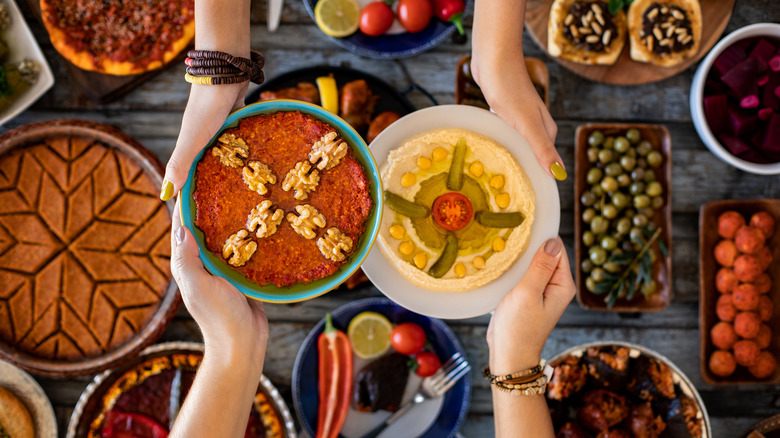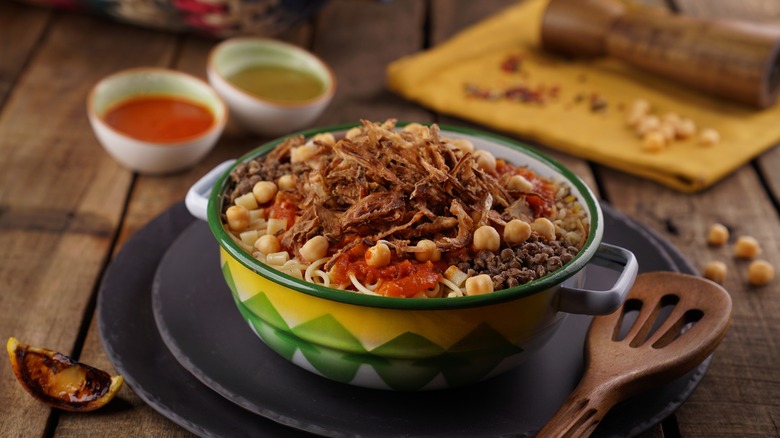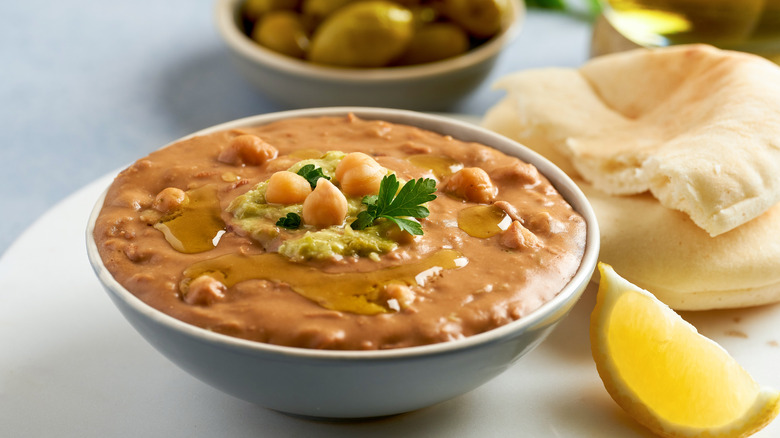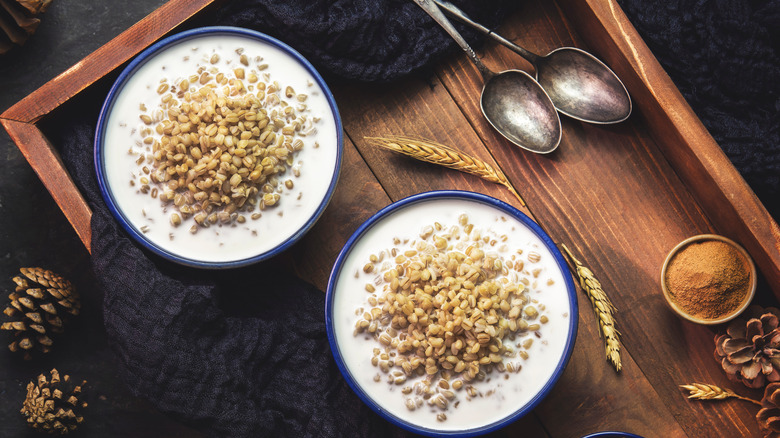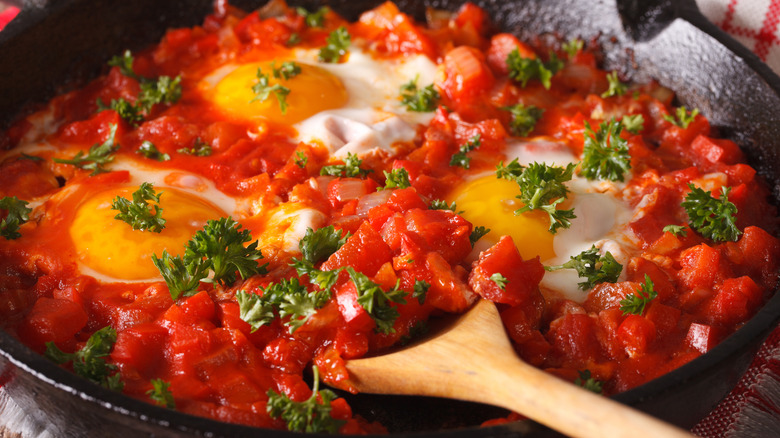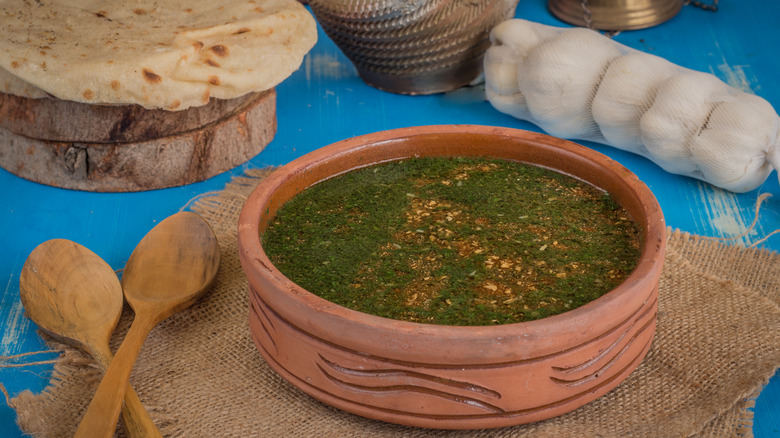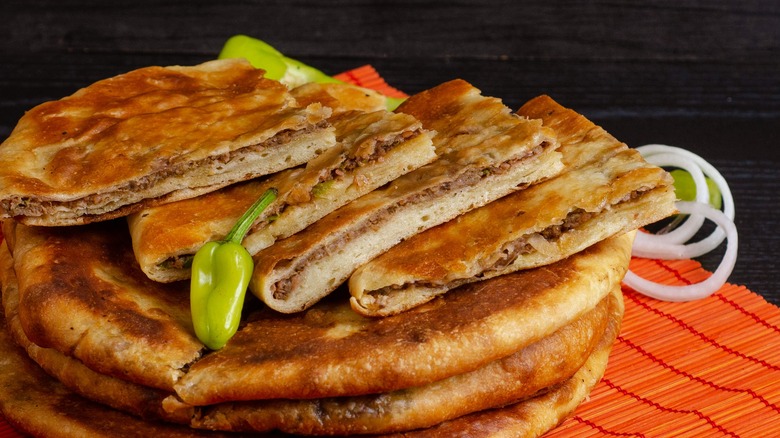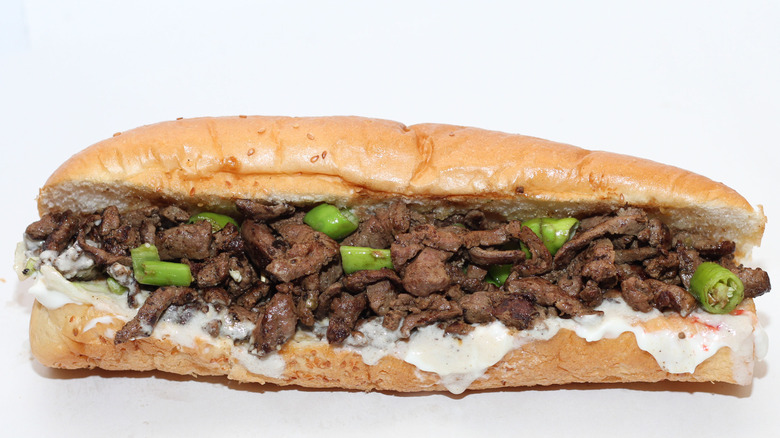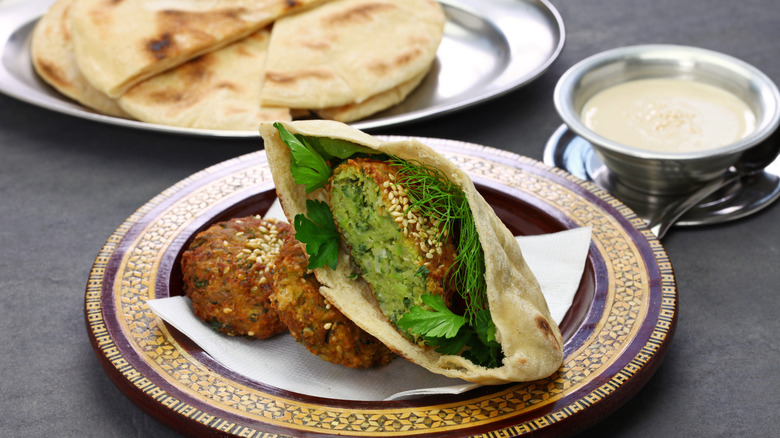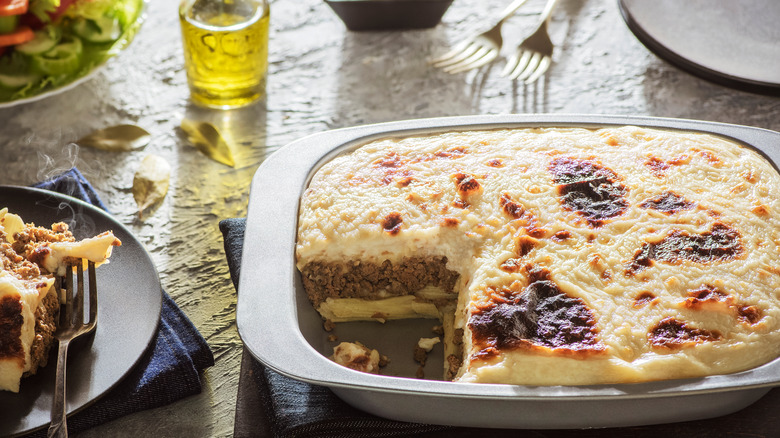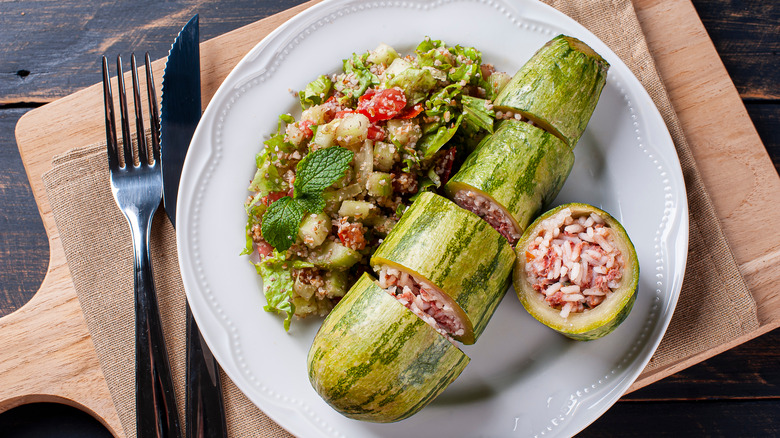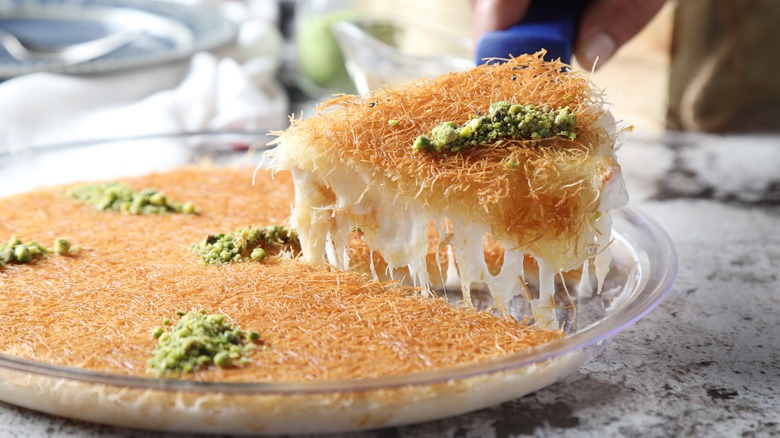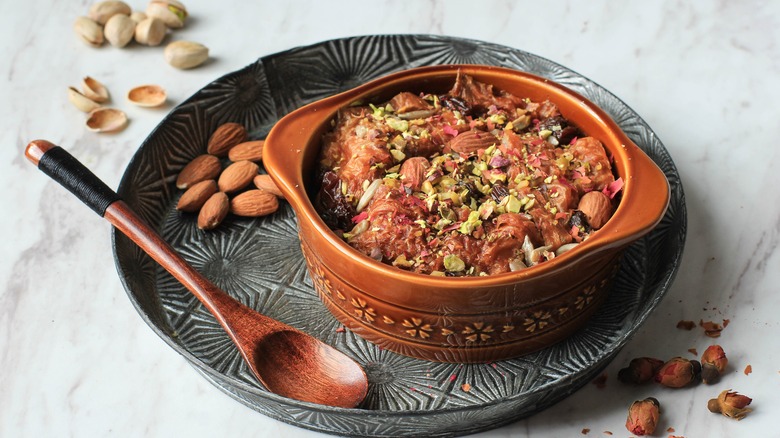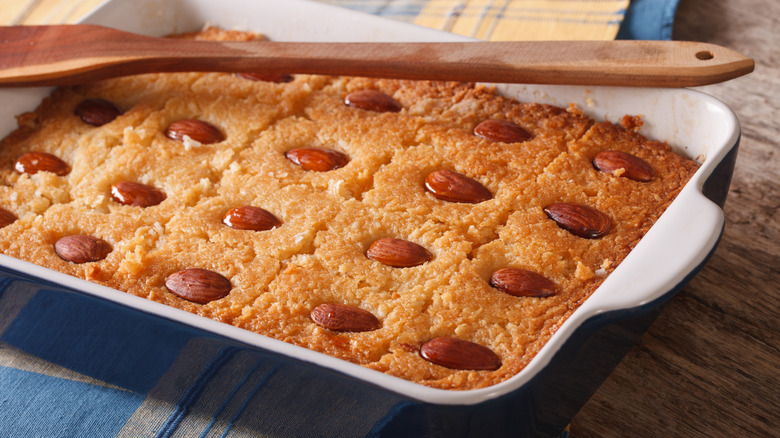Egyptian Dishes You Probably Haven't Tried Yet, But Should
Humans have been living in what is now the Arab Republic of Egypt for thousands of years. It sits at the crossroads of two continents, Africa and Asia, and borders both the Mediterranean and the Red seas (via Maps of World). Consequently, Egypt is a place rich with diversity as people from both regions have immigrated there for millennia (via UNESCO). This has deeply influenced its cuisine.
Because the Nile River valley is so fertile, Egyptian cuisine makes use of many fresh vegetables and legumes. Meat is expensive there, so many popular Egyptian dishes are vegetarian. Beans, lentils, and rice are staples of an Egyptian diet, as is bread (via The Foreign Fork). The word used for bread in Egypt (which has been eaten there since ancient times) is "aish," which literally means "life" (via Arab America). Expect to enjoy traditional Egyptian bread with 14 mouth-watering, must-try Egyptian dishes below.
Koshary
Koshary (also spelled koshari and kushari) is considered by many to be Egypt's national dish (via NPR). It's a vegetarian pasta dish made with macaroni noodles, lentils, rice, chickpeas, vinegar and tomato sauce, and is then topped with fried onions (via The Mediterranean Dish). Suzy Karadsheh of The Mediterranean Dish suggests pairing a bowl of koshary with a side salad. Ali Zayed told NPR that he loves to load his koshary up with hot sauce.
Unlike several others on this list, koshary is a newer dish that came to Egypt sometime in the mid-20th century. Food historian and author Claudia Roden told NPR, "I had never eaten or known of koshary in Egypt before 1952, when I went to school in Paris. No one ever mentioned the recipe when I was researching my first book almost sixty years ago." Everyone can agree, however, that koshary is totally Egyptian.
Whether homemade, ordered at a restaurant, or picked up from a street vendor, koshary is a must-try.
Ful medames
A simple breakfast stew of fava beans seasoned with lemon juice, olive oil, and garlic, ful medames has been beloved in Egypt for thousands of years. The remains of ful medames have been found in Egyptian pharaohs' tombs from the 12th Dynasty (via Taste Atlas). Ful medames has since spread to other parts of northern Africa and the Middle East. Its filling, nutritious nature has made it a popular food during Ramadan.
Ful medames is a popular street food often paired with Arabic bread (to soak up the savory stew) and pickled vegetables (via Migrationology). You can also make a sandwich out of these ingredients, making the meal easier to carry around as you explore the bustling Egyptian streets. The toppings can be simple or grand (via National Post). For example, try different combinations of spices, a fried egg, or fresh spring onions. The Egyptian government regulates the price of fava beans in order to ensure their affordability to the masses, reports Taste Atlas, making ful medames a great dish to play around with.
Belila
Belila, or wheat porridge, is another popular Egyptian breakfast that can also be eaten as a snack or even as dessert (via African Food Network). It is high in fiber and low in calories, but don't let that deter you. Journalist Jenny Gustafsson on Twitter says that Egyptian belila is meant to be sweet.
Food writer and recipe developer Nermine Mitry-Mansour says that the word "belila" comes from the French "Blé Au Lait" (via Chez Nermine). The current breakfast dish got its name during years of French colonialism at the turn of the 18th century. Mitry-Mansour said she has fond memories of her grandmother making belila when she was a child.
Similar to American cereal or oatmeal, belila is made with whole wheat berries soaked in hot water and topped with an array of fresh ingredients such as toasted nuts, anise seed, raisins, a bit of hot milk, cinnamon, rose water, and more (via Chef In Disguise). La Zisa, a restaurant within the St. Regis Cairo hotel, offers its enticing belila with raisins, icing, hot vanilla milk, and nuts.
Shakshuka
Shakshuka (also spelled shakshouka) starts with a tomato base cooked with onions, herbs, and spices in a skillet. Usually, eggs are then cracked into this savory sauce to poach. Based on region and personal taste, other things can be added to the mix such as sausage, bell peppers, or feta cheese. Seasoning can vary with this dish, but it is often paired with warmer selections such as red pepper flakes or paprika. While available all over the Middle East and northern Africa, the word shakshuka is Arabic for "all mixed up" or "shaken" (per The Mediterranean Dish).
Egyptian shakshuka is unique, however. Rather than leaving the cracked eggs to poach, they are mixed in with the tomato sauce base, resulting in scrambled eggs (via Kitchen Stories). With this thicker consistency, you can make a shakshuka sandwich. Shakshuka is commonly served with bread, so turning it into a sandwich seems a natural fit. Shakshuka is perfect for breakfast, lunch, dinner, or a quick snack.
Molokhia soup
Molokhia (also spelled mulukhiyah) is a nutritious leafy green plant native to Egypt with a taste and texture similar to okra (via Arab America). Health benefits of eating molokhia include better blood pressure, blood circulation, and better digestion (via Organic Facts). This may be why it has been a popular culinary ingredient since the time of the ancient pharaohs, when it was served only to royalty. The name actually comes from the Arabic word for "majestic" (via Arab America).
Also like okra, molokhia thickens the liquid in which it is boiled, such as chicken broth. Traditionally, the leaves are cooked with garlic, coriander, and chicken. Rabbit meat may also be used, and shrimp is popular in coastal cities like Alexandria (via Scoop Empire). To round out the meal, the soup is paired with rice or bread and a wedge of lemon or lime.
So if you want to eat like a king, grab a nourishing bowl of molokhia.
Hawawshi
Egyptian butcher Muhammad Al-Hawawsh invented his namesake sandwich in 1971 in Cairo (via Al Arabiya News). The Hawashi sandwich is composed of seasoned minced meat and vegetables stuffed into a pocket of traditional Egyptian baladi bread and then baked (via Taste Atlas). Baladi bread is like pita, but with a slightly different flavor and a recipe that dates back thousands of years (via Arab America).
Al-Hawawshi did not get a patent for his savory signature sandwich, and it quickly spread throughout Cairo and then to the rest of Egypt. Variations have arisen in the ensuing decades as new chefs added their own flair. According to Mediterranean Living, it is more common in Alexandria to stuff the minced meat mixture into dough rather than bread, and everything cooks together. It also reports that a vegan version was created using lentils for the tenth of Egypt's population that is Coptic Christian and eats mostly vegan.
Kebda Eskandarani
Originating in Alexandria, Kebda Eskandarani is another meat sandwich beloved by Egyptians. Marinated chopped liver is sauteed with peppers and onions and put onto a bun, then topped with tahini sauce (via Harvesting Nature). The liver of different animals can be used, from duck to water buffalo. Beef liver is so popular there that Egypt has become the largest importer of beef livers in the world, with the majority coming from the United States.
Street carts throughout Egypt can be found sizzling up liver for these iconic sandwiches. Cairo restaurant Kazouza says it's their most popular dish. Middle Eats says that the flavor of the kebda (liver) is tangy, and will win over even the most resolute liver skeptic.
Though high in cholesterol, liver has many health benefits, including a unique nutrient density (via WebMD). So what have you got to lose by giving this classic Egyptian sandwich a try?
Taameya
Falafel, a Middle Eastern chickpea fritter, has become so popular around the globe that it has its own day. That's right, June 12th is International Falafel Day. But have you heard of its possibly older Egyptian cousin, taameya?
Rather than a traditional base of chickpeas, taameya uses fava beans mashed with leeks, onions, coriander, parsley, cumin, and sometimes sesame seeds. Taameya, which may date as far back as ancient Egypt, can be eaten in the same ways as falafel. That is, it can be enjoyed alone or tucked into a pocket of bread with vegetables, greens, and topped with tahini sauce.
The texture of taameya is lighter, and not as dry as falafel. Taameya also uses more herbs, offering more color and flavor. Culinary anthropologist Claudia Roden told The Guardian that the best falafel recipe can be discovered in Egypt. With praise like that, how can anyone pass it up?
Macaroni béchamel
Béchamel sauce is one of the five "mother sauces" in French cooking. But food blogger Dahlia Morched remembers her Egyptian family using it in so many casseroles that she spent her childhood believing that the word "béchamel" was Arabic in origin.
This hearty, lasagna-like, layered pasta casserole is a real Egyptian favorite. Layer pasta and ground beef, then top it off with creamy béchamel sauce, and bake it all together until the top is golden, and you have macaroni béchamel (via Taste Atlas). The ground beef is often mixed with tomato sauce and a variety of spices, which add a pleasant contrast to the rich dairy of the béchamel sauce (via Every Little Crumb). Inside Egypt says that the traditional way is without tomato sauce. Also, macaroni béchamel may be the original Egyptian pasta dish that other pasta dishes in the country are based on.
With its rich creaminess, macaroni béchamel is not to be missed, with or without tomatoes.
Mahshi
To put it succinctly, mahshi are an array of vegetables stuffed with rice and occasionally also ground meat. Squash, peppers, tomatoes, eggplant, et cetera. Even cabbage leaves and grape leaves are sometimes used. It is believed the dish originated in the Ottoman empire and spread to Egypt (via 196 Flavors). According to renowned food blog Amira's Pantry, mahshi is one of Egypt's most popular dishes, especially during Ramadan. When made vegetarian, it can be a rich, flavorful, and inexpensive meal.
According to Taste Atlas, the cooked rice is mixed with mint, dill, parsley, bay leaves, cinnamon, or allspice. Amira's Pantry asserts that only fresh herbs should be used. The herb and rice mixture is then added to the cored vegetables before they are simmered slowly in a tomato broth. Vegan mahshi can be served either cold or warm, but the meat variety is always served warm, reports 196 Flavors.
Knafeh
Knafeh is a traditional dessert made from thin strands of cooked or baked wheat dough. Its name may have derived from the Coptic language many centuries ago. This unique pastry dish is then sweetened with simple syrup, crushed nuts, and, most enticing of all, cheese. Yes, cheese. Specifically, it should be sweet, stringy, melting cheese. Cheese.com suggests using nabulsi, a soft cheese made from sheep's or sometimes goat's milk. Nobelio recommends dil-peyniri, a Turkish string cheese.
According to Green Prophet, the sugar syrup is infused with rose water or orange-flower water. Rose water was used in ancient Egypt for both beauty and medicinal purposes (via Rose Water). Most often, rose water is produced in centers such as India, Oman, Iran, Morocco, and Lebanon.
Khaleej Times says that knafeh is a particular favorite during Ramadan, though it can be eaten just about any time, and is totally worth seeking out!
Om Ali
If koshary is Egypt's national dish, then om ali (also spelled umm ali) is the nation's national dessert (via Amuse). It's a kind of bread pudding made with puff pastry, raisins, pistachios, almonds, and coconut flakes saturated in a mixture of milk and sugar. Often, cinnamon is sprinkled over the top. It can be served both warm and cooled.
The story of Om Ali's creation dates all the way back to the 13th century. According to legend, after the assassination of the sultan Izz al-Din Aybak by one of his wives, the sultan's first wife had her servants use whatever was on hand to make this special dessert to share with the people and announce her son, Ali, as the sultan's successor. Om Ali translates to English as "mother of Ali."
Between the soft pastry, creamy milk, and crunchy nuts, Reddit user ObiEff describes Om Ali as "a wonderful mouthful of alternating textures."
Basbousa
A sweet cake made from semolina flour and drenched in syrup, basbousa is another popular Egyptian dessert. Nicole Azzopardi says that her Alexandrian grandmother called the dish "harissa" and flavored it with rose water. Basbousa has a buttery flavor and unique, almost sandy texture. You will typically see the cake cut into rectangular or diamond-shaped pieces with almonds placed on top of each piece.
According to the health food blog Healthy Life Trainer, basbousa has its roots in the Ottoman dessert ravani. Greek Goes Keto claims that basbousa and ravani both originated in Egypt. The name basbousa translates to "just one kiss" from Arabic.
Today, basbousa is regularly enjoyed at a number of religious celebrations, both Muslim and Christian. "I grew up eating Basbousa at every holiday, family get-together, and celebration," said Yesmina Salib. And while it may often be found at celebrations, you don't need a special occasion to enjoy this beloved sweet treat.
Sahlab
Egyptian Elegant Tours calls sahlab (also called salep) both a "sweet warm drink" and "the best Egyptian dessert." Sahlab is made from warm milk and orchid root powder, which is used as a traditional thickener. It can be flavored with things like vanilla, sugar, and cinnamon, and can be topped with shredded coconut, crushed nuts, or raisins. It's really up to personal preference.
Nowadays, according to 196 Flavors, genuine orchid root powder is uncommon and expensive. Sorghum flour or cornstarch are often used as substitute thickening agents and imbued with artificial orchid flavoring. While sahlab is enjoyed across the Middle East and lands of the former Ottoman Empire (it even made its way to England before the introduction of coffee and tea), Egyptians prefer it a little sweeter.
Orchids have been considered an aphrodisiac since ancient Greece, so is it any wonder so many have fallen in love with this cup of warm indulgence?
